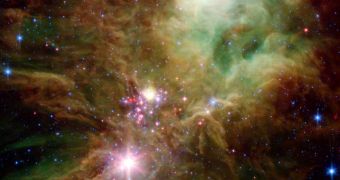For many years, the prevailing theory to explain how stars are born was that they develop inside stellar clusters, but a new paper that argues against this mainstream opinion has just been published.
The work casts doubt as to whether all stars actually appear inside stellar nurseries, where conditions are ripe for this to happen.
Inside such a cosmic structure, massive clouds of dust and gas are constantly churned up by radiation emanating from stars, or coming in from nearby cosmic fireballs.
As this happens, the gas mixes until a large enough mass eventually collapses in on itself. As this happens, the massive amount of chemicals ignites due to friction, and a new star is born.
Over time, it starts to accumulate more and more matter, and becomes capable of sustaining nuclear fusion all on its own. It can then be case out of the stellar nursery, and head for other locations.
Until recently, astrophysicists believed that small dust clouds, which featured only enough mass to form a single star, could not condense and ignite, because the proper conditions were not met.
The main issue the new study detects is that it's very difficult to determine when a star is gravitationally bound, i.e. part of a stellar nursery, and when it's free.
The number and strength of gravitational interactions between stars in a cluster changes constantly, and so establishing an exact line of demarcation becomes increasingly difficult.
In addition to cluster, that are other types of groups of stars as well, such as for example associations. Stars in such structures appear linked, but they actually function independent of each other.
They are not truly bound to each other in any sense, which means that the velocity of the stars themselves is sufficient to eventually break the entire structure apart.
What the research team showed is that the amount of newly-produced stars belonging to a stellar cluster depends entirely on the definitions experts use to designate the large cosmic structures.
The group, which was led by University of Exeter expert Eli Bressert, conducted the study using the Spitzer Space Telescope, which surveys the sky in infrared wavelengths.
The instrument is capable of peering deep into the heart of stellar nurseries, which means that it can penetrate the thick layers of dust surrounding and covering new stars.
Observatories that function in visible light wavelengths cannot observe these processes, Universe Today reports.

 14 DAY TRIAL //
14 DAY TRIAL //